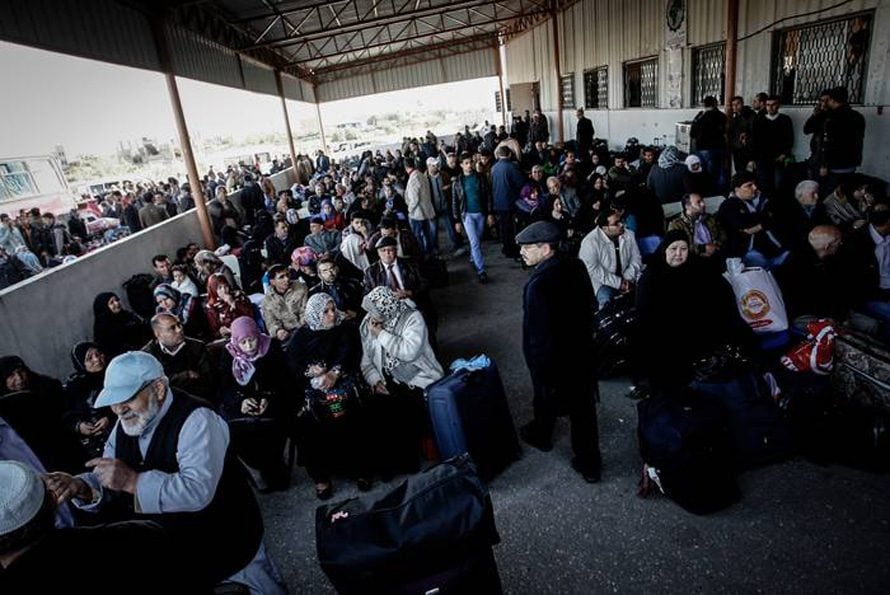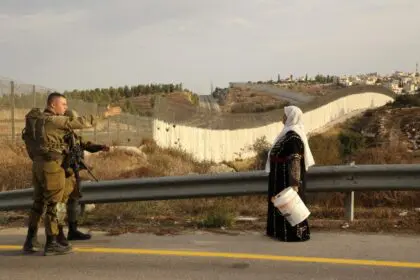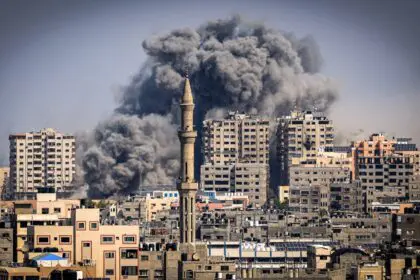UN OCHA 2011 Report on Gaza Blockade: a denial of basic human rights in contravention of international law & amounts to collective punishment.

Introduction
A report issued in October 2011 by the UN Office for the Coordination of Humanitarian Affairs (OCHA) stated that the Gaza blockade by land, air, and sea is ‘a denial of basic human rights in contravention of international law and amounts to collective punishment. It severely restricts imports and exports, as well as the movement of people in and out of Gaza, and access to agricultural land and fishing waters. Gazans are unable to provide for their families and the quality of infrastructure and vital services has deteriorated.’
Before Israel’s full siege of Gaza in 2007, there were six official crossings into Gaza: Erez, Karni, Nahal Oz, Kerem Shalom, and Sufa (with Israel), and Rafah (with Egypt). Before 2007, an average of 70 truckloads of exports left Gaza per day, and 583 truckloads of goods and humanitarian supplies came in. Most of the goods passed through Karni, in the northeastern Gaza Strip.
The main pipeline for the import of fuel (such as that consumed by the power plant in Gaza) was based at Nahal Oz.
Since June 2007, Karni has been shut down, apart from a conveyor belt that delivers grain over the huge concrete perimeter-wall. Sufa was closed entirely in September 2008. Most goods allowed into Gaza now enter through the much smaller Kerem Shalom crossing point in the south, which functions only part of the time. In the first two years of the blockade, an average of just 112 truckloads per day—one-fifth of previous transits—were allowed into Gaza.
Exports have been entirely banned, except for a few small shipments. Erez, in the north, has facilities to process large numbers of people entering and exiting Gaza but now deals with only a few foreign visitors, such as aid workers and the handful of Palestinians permitted to leave the Strip in exceptional cases, mainly for medical treatment or study abroad.
The Gaza Strip’s economy will never be able to reach its full potential as long as Israel continues to restrict external trade, including with Israel, and trade to and from the West Bank. Israel limits access to agricultural land and fishing waters, and there is a chronic shortage of electricity. Current constraints discourage investment, prevent sustainable growth, and perpetuate high levels of unemployment, food insecurity, and aid dependency.
Even though Gaza’s economy showed slight growth, at an average rate of 16 percent, between 2011 and 2012, this just reflects the low economic state from which it had rebounded. The growth was attributable to higher aid inflows, the easing of restrictions on entry of goods from Israel after the Israel attack on the Gaza flotilla mid 2010, and increased purchases through tunnels from Egypt.
Most of the growth, before the recent wave of restrictions, was driven by the construction sector, which expanded by 40 percent, contributing almost 8 percent to Gaza’s growth in 2012. The construction sector had improved by the building materials, more than 80 percent of which came through tunnels from Egypt.
Before the Israeli blockade in 2007, Gaza’s average imports through the Israeli crossing comprised 583 truckloads. In contrast, the average in the first half of 2013 was only 270 truckloads, leaving Gaza’s economy heavily dependent on Egypt’s tunnels.
Egypt, Gaza and the tunnels

After the Arab-Israeli War of 1948-1949, the Gaza Strip remained under Egypt’s military administration until its occupation by Israel in the 1967 June War. In this period the Sinai Bedouins and the Palestinians in Gaza continued to mingle through intermarriage and social contacts.
This ended when the southern border city of Rafah was split following the 1979 Egypt-Israel Peace Treaty, leaving it divided between Gaza and Egypt. As soon as the agreement was implemented, underground tunnels were dug in home basements across the 14-kilometre long Gaza-Egypt border. Israel’s first recorded discovery of a tunnel was in 1983.
After signing the Oslo Accords, Israel built a high barrier around Gaza. Access to the Gaza Strip was monitored through Israel’s terminals, but when the Second Intifada broke out in 2000, Israel often closed down the terminals and destroyed Gaza’s sea- and airports. Existing tunnels were subsequently upgraded and new ones dug to supplement the shortages which were a direct result of Israel’s strict control on all traffic of goods and materials.
The Israeli military, in the knowledge that the tunnels were also used for arms trafficking, began to demolish homes that harboured tunnels and later expanded the demolitions, creating a buffer zone between the border and Rafah City.
According to Human Rights Watch, some 1,700 homes were destroyed between 2000 and 2004 in order to create a 100-metre wide buffer zone along the Gaza-Egypt border (the so-called Philadelphia Corridor, known in Israel as the Philadelphi Road).
In addition, while implementing its unilateral withdrawal plan from the Gaza Strip in 2005, Israel built an 8-metre high wall. The Mubarak regime in Egypt supported the construction of the wall and the demolition of the tunnels as it would safeguard against any kind of activity that might threaten Egypt’s lucrative tourist industry along the Red Sea.
In addition, Egypt feared that Israel’s withdrawal would saddle Egypt with the responsibility for Gaza’s 1.7 million inhabitants, disconnecting it from the West Bank, and thereby obstructing the foundation of an integral Palestinian state.
In January 2006, after Hamas won the Palestinian general elections, Israel responded by systematically tightening its borders and imposing a full-scale blockade of the Strip. Israel closed the Erez terminal to Gazan labourers working in Israel (who at that time constituted 70 percent of Gaza’s workforce). It also shut down the Karni terminal, Gaza’s primary crossing for goods, and it prevented the use of the Rafah terminal for passenger traffic.
The array of restrictions on trade and human traffic in and out of the Gaza Strip, coupled with regular Israeli attacks, prompted Palestinians to dig deeper and longer tunnels. A wide variety of goods was transported through the tunnels – from building materials and food to medicine and clothing, from fuel and computers to livestock and cars. Soon on a yearly basis goods valued between USD 500-700 million were transported through the tunnels (Crisisgroup report).
For those involved, the tunnel business brings great risks. Many work 12-hour shifts, six or seven days a week, in cramped spaces. Since 2006 gas explosions, electrocutions, caving tunnels and Israeli air strikes caused the deaths of 232 Palestinians, leaving another 597 injured according to the al-Mezan Centre for Human Rights.
After the downfall of the Mubarak regime and its replacement by a Muslim Brotherhood government, led by Mohammed Morsi, Hamas expected a fundamental change of policy towards the Gaza Strip. Indeed, many high-level Egyptian delegations visited Gaza, including an official visit by the Muslim Brotherhood, followed by Members of Parliament and of the Salafist al-Nour party.
In late 2011 Gaza Prime Minister Ismail Haniyeh was allowed to leave Gaza for the first time since 2007, embarking on regional tours. Hamas was permitted to open an office in Cairo and to deal and meet with officials of the Foreign Ministry and President Morsi himself. In February 2012, Haniyeh held the Friday sermon at the al-Azhar Mosque.
After an attack on Israeli civilians in August 2011 by Egyptian militants and the killing later that day of six Egyptian soldiers by Israeli forces, thousands in Cairo demonstrated in front of and then stormed the Israeli embassy, demanding that Egypt break all ties with Israel.
In March 2012, after Israeli violence against Gaza escalated, the Egyptian Parliament passed a motion to halt gas sales to Israel, expel the Israeli ambassador and endorse a parliamentary committee report proposing to reverse Egypt’s course of action toward Israel.
However, relations between Egypt and Gaza remained strained over the Gaza blockade – much to the disappointment of Hamas and the Gazan Palestinians. After the downfall of the Mubarak regime, Salafists in the Sinai Peninsula took advantage of the security vacuum and stepped up their armed resistance to the central government.
They killed some tribal leaders who were advocating a deal with the government. The former regime had largely neglected the Sinai for decades. It is a region suffering from poverty, a lack of resources and unemployment.
Salafists started to attack garrisons in Northern Sinai on a regular basis. On 5 August 2012, sixteen Egyptian soldiers were killed on the border with Gaza. The government responded with heavy attacks and on 24 September 2012, fourteen Salafists were sentenced to death for the murder of Egyptian policemen.
In May 2013, seven Egyptian security men were abducted by Salafists demanding the release of those sentenced to death. The policemen were freed after mediation by tribal leaders and the army. In an effort to restore order, the Egyptian authorities asked Israel to allow the Egyptian army to deploy more forces in the Sinai.
The Egyptian media subsequently started a campaign blaming Hamas for not controlling its side of the border. Since the Egyptian military ousted the Morsi government on 3 July 2013, this media campaign has reached unprecedented levels, with Egyptian satellite TV channels and social media rumouring that the Palestinians, for example, want to occupy the Sinai and are interfering in Egypt’s internal affairs, causing turmoil, and are even responsible for attacks on Egyptian security forces by militant groups in the Sinai.
The allegations have been levelled at Palestinians in general, and Hamas in particular. The rumours were undoubtedly fed by press reports on 17 June 2003 – weeks before the ouster of President Morsi – stating that Hamas had sent 3,000 troops into Egypt to support Morsi.
Such claims have been used to justify Egypt’s efforts to destroy the tunnels between Gaza and Egypt, a lifeline for Palestinians in Gaza under Israeli blockade. The UN Special Coordinator for the Middle East Peace Process, Robert Serry, told the UN Security Council on 24 July 2013 that 80 percent of tunnels into the Gaza Strip from Egypt are ‘no longer functioning’ due to a crackdown by the Egyptian military.
He added that the Gaza Strip was experiencing ‘some serious shortages of fuel and basic building materials for which the tunnels had become the primary entry point due to severe restrictions on imports via the official crossings and the higher cost of fuel available from the West Bank and Israel’. Food prices have shot up and the lack of petrol created long queues.
Another measure taken by the military immediately after the overthrow of the Morsi government was to ban Palestinians from entering Egypt through Cairo Airport, preventing thousands of Palestinians from returning home to Gaza through the Rafah crossing – the sole point of entry and exit for the vast majority of Gaza’s residents.
The Gaza Siege after the Egyptian shut down of the tunnels in July 2013

The tunnels were, until their closure by Egypt, the main entry point for construction materials into the Gaza Strip, as the import of basic construction materials for the private sector through Kerem Shalom, the official trade crossing with Israel, remains severely restricted.
Egypt began closing the tunnels after General Sisi’s coup against the Muslim Brotherhood government of President Morsi, which had good relations with the Hamas regime in the Gaza strip. The military-backed government that succeeded Morsi actively opposes all manifestations of the Muslim Brotherhood, including Hamas.
In 2013, with the closure of most of the tunnels, the construction sector operated at less than 15 percent of its previous capacity, leading to the loss of more than 30,000 jobs.
Raw materials made up the majority of imports through the Egyptian tunnels. Before the new measures, Gaza’s businesses received more than 45 percent of the needed raw materials via the tunnels, leading to a noticeable increase in operating businesses.
Currently, due to Egyptian measures, more than 60 percent of industrial businesses are shut down, and the rest are operating at partial capacity. The sector currently employs 7,500 workers, down from 27,000 before 30 June 2013 (35,000 before 2006).
Economists expect that the continuous closure of the tunnels will lead to a sharp decline in growth (3 percent by the end of 2013) and an increase in unemployment (43 percent by the end of 2013, compared to 32 percent in June 2013).
The Palestinian Federation of Industries estimates that, on average, approximately 1,500 tons of construction materials entered Gaza through the tunnels per day in the last months of 2013, compared to 7,500 tons before the closure of the tunnels.
The price of construction materials on local markets rose sharply before declining to 20-30 percent above the normal price by the end of July 2013; this led to a sharp downturn in construction activities and the output of concrete plants.
The Ministry of Economy in Gaza stated on 28 August 2013 that, ‘as a result of the Egyptian political crisis, the economy in the Gaza Strip has endured severe losses worth USD 460 million in all economic sectors within the past two months.
The industry sector is suffering from a USD 69 million loss, the agriculture sector USD 68,3 million, the services sector USD 92 million, the transport sector USD 83.4 million, the construction sector USD 89.1 million, and domestic trade USD 57 million.’



